Egypt, art during the Early New Kingdom Dynasty XVIII
The end of the Second Intermediate Period and the beginning of the New Kingdom were ushered in by the reign of Nebpehtyre Amossi I (Ahmose) (1570-1546 B.C.) Although, his tomb has never been identified, that of his mother (Queen Ahhotep)
has been found in Western Thebes at Dra Abu el-Naga. The quality and profusion of precious jewels, including lapus lazuli, in her tomb is exceptionally high and demonstrates the bounty of Egypt’s military
successes in Asia and Africa.
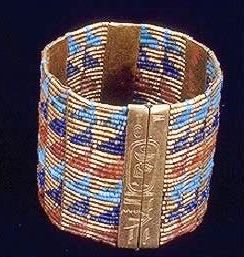
Gold with lapus lazuli and other precious beads; bracelet, Queen Ahhotep, name of King Ahmose I inscribed on the clasp; Dynasty XVIII; Egyptian Museum, Cairo.
After Avaris was re-captured from the Hyksos, and Upper and Lower Egypt were reunited, the central administration was made secure, and fortresses, particularly in the north and west, were reinforced. But Ahmose
died and his son was only a child. Egypt was ruled by Queen Ahmose-Nefertari (1546-1526).
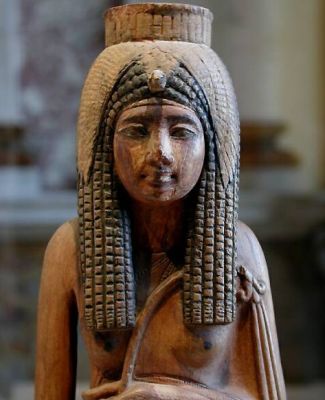
Wooden statue of Queen Ahmose-Nefertari, excavated at Deir el-Medina, Dynasty XVIII; 43 cm; Fondzione Museo Antichita Egizie, Turin, Italy.
Amenhotep I (1526-1506 B.C.) stretched the southern border significantly beyond the Third Cataract, but his rule was relatively peaceful and prosperous. There was more construction. Royal tombs
were now separate buildings from mortuary temples. There is evidence that Amenhotep I created a dedicated corps of craftsmen to work on the royal necropolis at Deir el-Medina in the Valley of the Kings.

Sandstone statue of King Amenhotep I (1526-1506 B.C.) 71.1 x 27.9 x 61 cm; Brooklyn Museum of Art, New York.
The reign of Amenhotep I was a period of medical advances. There are many extant medical papyri from the XVIII Dynasty. Because embalming was a part of the Egyptian funerary ritual, Egyptian doctors understood
more about anatomy than many of their ancient counterparts. The Ebers Medical Papyrus is the first document with detailed descriptions of ailments and prescriptions. Some of the typical illnesses
described in the Papyrus are toothaches, eye infections, and migraines.

Portion of the Ebers Medical Papyrus; ca. 1550 B.C.; purchased by German Egyptologist Georg Ebers from collector Edwin Smith in 1862. University of Leipzig Collection, Germany.
Religion was a big part of medicine in antiquity; exorcisms and prayers were considered medical treatment. According to Egyptian religion, humans were made of five elements: ka (life force);
ba (individual spiritual identity); the person’s name; the human’s shadow; akh (a state in which the person was illumined, which allowed the dead to join the stars.)
During Dynasty XVIII, shabtis (funerary ritual statue), began to appear in fields and other ordinary places, rather than only in tombs. From the Middle Kingdom, the wealthy put shabtis in their tombs to act as servants in the afterlife. The use of shabtis in fields showed that religious objects once available only to the elite were now affordable for those of modest means.
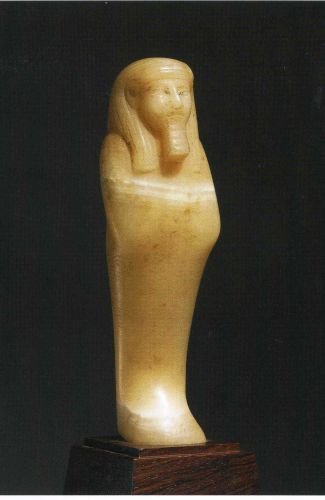
Shabti, alabaster, early Dynasty XVIII, 14.1 cm, private collection.
King Akherperkare Tuthmosis I (1506-1493 B.C.) was probably the first king to be buried in a tomb cut into the cliffs of the Valley of the Kings. This was at Thebes on the west bank of the Nile.
His tomb, and those of kings after him, had a series of rooms and corridors, with the burial chamber at the back. The rooms often went several hundred feet into the rock. The walls were completely filled
with sacred texts and images, to help the deceased on his voyage to a good afterlife.

Funerary Stele (monument); Dynasty XVIII, 42.9 x 21.1 x 4.2 cm; Brooklyn Museum of Art, New York. The top of the stele is rounded to emulate the sun's progress across the sky. The deceased-Sen-Res-is smelling a lotus. The blue lotus was connected with the Egyptian creation story; some scholars believe the lotus had medicinal uses in ancient Egypt.
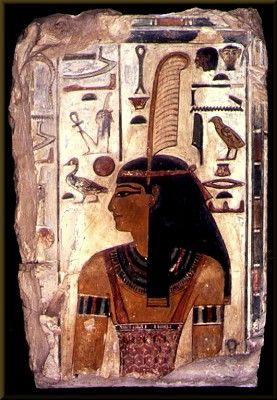
Funerary wall relief portrait of the Goddess Maat; limestone; 74 x 47 cm; Dynasty XVIII; Museo Archeologico Nazionale/Museo Egizio; Firenze, Italy. The inscription says: "Maat, daughter of Ra, who presides on earth in the kingdom of the dead." The feather in her headdress is a symbol of justice, harmony, and truth. In Egyptian religion, someone who died was not guaranteed a good afterlife. Among the tests he had to pass was for his heart to be weighed on a scale against the feather of Maat. If the heart weighed less, the deceased would have a good afterlife.
In the Egyptian creation myth, the chaos of the universe was defeated by the God Ra—that was the beginning of life. But chaos always threatened to come back and destroy life. The
Egyptians perpetually feared disorder, and they believed that it was only through the intervention of Ra that the forces of chaos were defeated each night. The personification of the forces of chaos
was the serpent Apep. Starting in Dynasty XVIII, the myth of Ra defeating Apep was depicted on funerary papyri and the tombs of royalty. In this myth, when Ra is victorious over Apep in the seventh
hour of the night. When Ra defeats Apep, the boat carrying the sun can rise, and rebirth occurs.
Also in Dynasty XVIII, royal funeral rituals were held close to farms, at the edge of the Nile, in a national temple to a group of gods including Amun-Ra. Before this time, royal funeral rituals were
performed at the place of entombment.
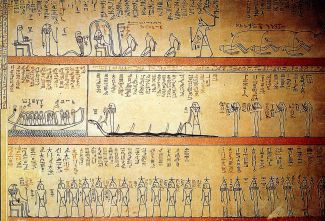
Tomb of Amenhotep II, Valley of the Kings, Tomb 35; Painted wall depiction of the seventh hour, with the solar boat, and the snake Apep. At the very bottom, the god Horus lectures the personifications of the hours, "who protect Ra and fight for him in the underworld."
A veneration for the forms of the Old Kingdom dominated architecture and art during the reign of the female king Makare Hatshepsut (1503-1482 B.C.) At first Hatshepsut was simply the regent for her son, Thutmosis
III. But in the seventh year of his rule, she had herself crowned, wore the kingly paraphernalia (including the false beard) and took on the titles of the king. She claimed that her father Thutmosis
I had made her co-regent with him.
Her tomb at Deir el-Bahri was identified by archaeologists in 2007, though it had been excavated in 1903 by Howard Carter.

Fragment, limestone raised relief of Queen [Pharaoh] Hatshepsut from her mortuary temple, ca. 1460 B.C.; 32.7 x 25.4 cm; Private collection.
Dynasty XVIII was a prosperous time, agriculture thrived and quarries were more productive. The tribute of gold from Lower Nubia during this period was about 500 pounds per year. Iron was worked extensively
for the first time in Egypt during Dynasty XVIII.
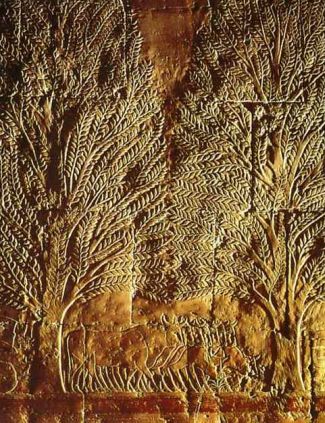
Portion of relief from mortuary temple of Queen [Pharaoh] Hatshepsut; Deir el-Bahri. This section shows part of the trading expedition to Punt, thought to be in either modern Sudan or Eritria. Cattle, trees for incense, as well as the skins of exotic animals such as leopards and panthers were taken by the Egyptian overlords, for use in religious ceremonies or by the royalty.
Hatshepsut's favorite administrator-Senenmut-was responsible for building her tomb at Deir el-Bahri. Senenmut seems to have been born into a peasant family. He rose through the ranks of the Egyptian bureaucracy
by dint of his capabilities; the Egyptian bureaucracy during this time became a meritocracy. His tomb was unique in containing many literary and religious documents, as well as the first known ceiling with map
of the constellations. Senenmut, in addition to being chief advisor to Hatshepsut, was also the official tutor to her daughter Nefrura. After Nefura's death, Senenmut tried to negotiate with Hatshepsut's step-son
and rival for the crown, Thutmose III. Hatshepsut heard about the negotiations and fired Senenmut.

Detail, painted limestone wall, the god of death Anubis, mortuary temple of Hatshepsut, architecture, planning and design by Senenmut; Deir el-Bahri, Egypt.
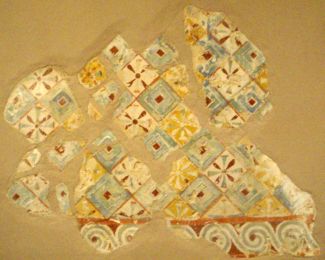
Detail, ceiling of tomb of Senenmut, Metropolitan Museum of Art, New York.
Hatshepsut probably died in about 1458 B.C., but she may have been overthrown by her step-son and successor Thutmosis III. By 1458 B.C. it is clear that he had complete sovereignty. There may have
been some connection between Thutmosis III’s rise to power and his defeat of an uprising by the Syrians, which coincided with Thutmosis III appearance as pharaoh and Hatshepsut’s disappearance.
He was known as the warrior king, and conducted sixteen successful military campaigns in his twenty years of rule. The southern borders reached the Fourth Cataract of the Nile under Thutmosis III.
The country was immensely prosperous and this led to more building and more artistic production.
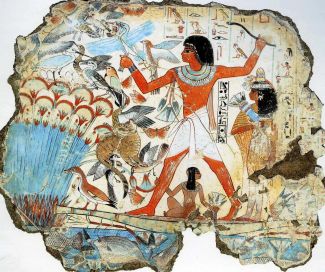
Fragment of relief from tomb of the official Nebamun at Thebes, Dynasty XVIII; hunting birds in the marsh, the detailed treatment of the animals demonstrates the high level of craftsmanship common during this period even in non-royal tombs. British Museum, London, U.K.
Prosperity during Thutmosis III’s rule filtered down through the bureaucracy. For the first time, we see elaborate murals—including depictions of the king-- and statues in the tombs of important
officials. Mud was plastered over the limestone walls and square grids were drawn in red. Figures were painted in according to the grids. (Gay Robins, The Art of Ancient Egypt, revised
edition, Harvard University Press, 2008, pp. 140-141.)

Fragment from tomb of Sebekhotep, assistant to the Pharaoh, Thebes. Depicts Syrians bringing horses as tribute to the Egyptians. British Museum, London, U.K.
By the time of Thutmosis IV, Egypt was trading with most of the Mediterranean world. Inlays of gold and silver were now common as were black bronze and a proliferation of glass objects. Garments
for both men and women are flowing with folds, perhaps influenced by contact with the Greeks. There are more small statues of women, mostly in boxwood imported from Asia.
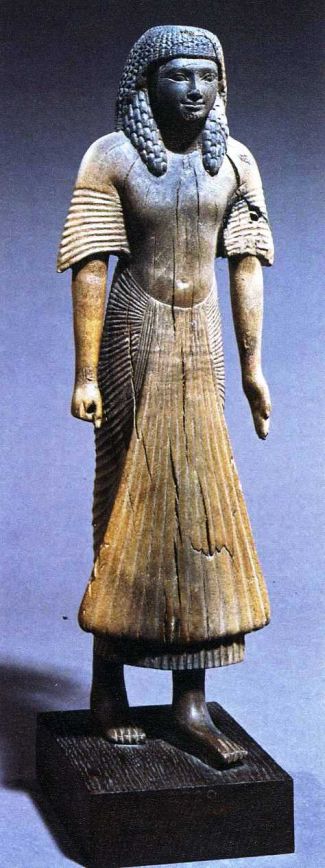
Statue of an unnamed administrator, wood, 29.2 cm; Dynasty XVIII; the garment was probably linen, and shows the pleats popular at the time. British Museum, London, U.K.
Increased, sometimes brutal, realism in portraiture marked the periods of Thutmose IV and his son Amenhotep III. This was a time of consolidation of empire and wealth-spreading throughout Egypt. There
were massive building projects including the temple to Amun-Ra at Luxor, a Pylon at Karnak, and Amenhotep III’s mortuary temple in Western Thebes. Scholars now believe that Queen Tiye served
as co-regent with Amenhotep III for at least part of his reign, and retained political power under the reign of her son Amenhotep IV, who changed his name to Akhenaten. (“Johns Hopkins Team Discovers Statue
of Egyptian Queen,” Science Daily, 30 Jan. 2006.)
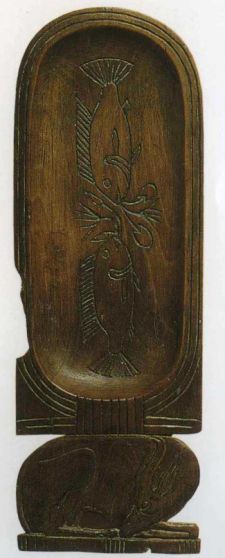
Spoon for use with cosmetics; wood; Dynasty XVIII; during this period men and women wore make-up. Eye make-up in particular was almost universally worn and was believed to have magical, medicinal, and appearance-enhancing qualities.
Women occupied some important positions during the XVIIIth Dynasty, but were still subject to the authority of their husband, father or brother. There were female priests, who in addition to religious duties
had financial power. Queen Tiye was not of royal birth, yet unlike many other queens, was depicted in official portraits alongside her husband King Amenhotep III.

Fragments of the funerary mask of Queen Tiye, wood with remnants of gold leaf; ca. 1352 B.C. Egyptian Museum, Berlin, Germany.
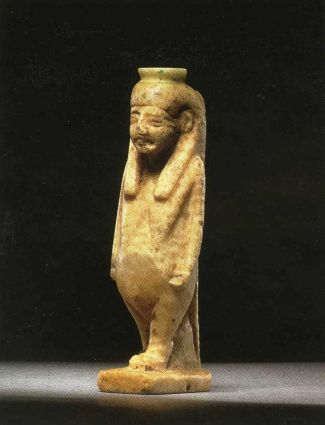
Amulet of Queen Tiy, alabaster, 7 cm; Queen Tiy in the guise of the Goddess Tawret, who takes the form of a pregnant hippopotamus. ca. 1350 B.C.; private collection.
The reign of Akhenaten (Amenhotep IV) (1352-1338 B.C.) was unique in Egyptian history. After the first two years of rule that basically duplicated his father’s, Amenhotep IV made the god Aten (the sun
disk) the primary god of Egypt, displacing Amun-Ra. In the distant Egyptian past, Amun was warrior god. The center of Amun worship was Thebes. Ra was the god thought to be the creator of the
universe. Akhenaten switched the capital to Akheten. The period of his reign is known as the Amarna Period.
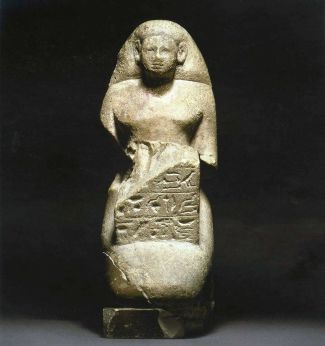
Limestone statue, male kneeling with prayer to Amun-Ra; Dynasty XVIII, 30.4 cm; private collection.
The unusual physique of Akhenaten—his elongated features, head with a protuberance on the end, soft, feminine hips--has spurred all sorts of scholarly speculation. Some believe he had Marfan’s syndrome,
a disease of the spine. A more commonly-held belief is that by incorporating all the different iconographical elements, Akhenaten wanted to demonstrate his radical departure from the past. Akhenaten
was invariably portrayed in this stylized, distinctive way. However, as time went on, others from his family and his government officials were depicted in a fashion more typical of Egyptian art up to his
time. They did not have Akhenaten’s long face, distorted physique.
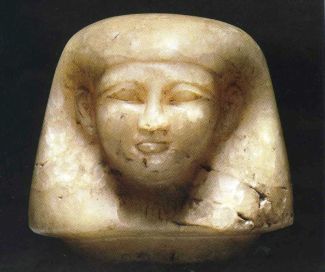
Canopic jar lid, alabaster, Dynasty XVIII; the lid takes the form of one of Horus's four sons: Imsety, protector of the liver, who in turn was protected by the Goddess Isis, associated with fertility and germination of crops. 12.6 cm; private collection.
During Akhenaten’s reign, many family scenes were depicted on reliefs and sculpture. It was the first time in Egyptian history that the Pharaoh’s family was made so prominent. His Queen,
Nefertiti, is one of the most well-known queens in human history.

Queen Nefertiti, stone relief, from Abadaya Grave; formerly in private collection in Switzerland, bought at auction in 1979 by the Ashmolean Museum, Oxford, U.K.
History does not record how the reign of Akhenaten ended. There was a rapprochement between the pro-Amun and the pro-Aten factions. For a short period Semenkhkare was co-regent with Akehnaten and survived
him for perhaps a few months.

Jar, alabaster, Dynasty XVIII; 9 cm; private collection.
Akhenaten and Smenkhkare were succeeded by Tuthankamun, who was then about nine years old. Today, Tuthankhamum is renowned because of the spectacular, nearly intact contents of his tomb found in excavations
by the Englishman Howard Carter in 1922. One robbery of the tomb had taken place, probably in antiquity, and priests had rehabilitated, cleaned, and closed it up again. Carter had been digging in
the area for five unsuccessful years before finding Tuthankamun’s tomb.

Wooden model of coffin and mummy, Dynasty XVIII, private collection.
The plan of Tuthankamun’s tomb differs from the others dating from the Dynasty XVIII. It has four small rooms accessed by sixteen steps and a short hallway. Most scholars believe the tomb was unfinished
when Tuthankamun died at age seventeen. Some of the objects buried with him seem to have dated from his childhood—a tiny chair, a bracelet that could only fit someone very small.

Portion of a wall relief from the time of Tutankhamun, showing olives being cultivated. Private collection.
Tutankhamun was succeeded by Kheperkheprure Ay, a geriatric noble who married Tutankhamun’s widow to shore up his claim to political power. Ay was king from 1352-1348 B.C. After him came Djeserkheprure
Horemheb, who had been the preeminent general under Akhenaten. He ruled from 1349-1320 B.C. Under Horemheb, Egypt’s economy and domestic politics stabilized and foreign relations were strengthened;
the status quo before Akhenaten was restored.

Gold dagger, from the tomb of King Tutankhamun, Carter # 256dd; 31.9 cm; blade 20.1 cm; Egyptian Museum, Cairo. Two similar daggers were found in Tutankhamun's tomb, one with a gold blade (in image 26) and the other with an iron blade. Gold daggers were reserved for the nobility, but bronze or copper daggers were used from the Old Kingdom on in Egypt.
Horemhab was not related to the royal family of the Dynasty XVIII His reign is considered a transition to Dynasty XIV, whose first ruler was Ramses I. Under Horemhab’s rule, all traces
of Akhenaten and the worship of Aten were officially banned, the names of all members of the Akhenaten family were erased from official documents. The city Akhenaten established at Akhetaten was destroyed.
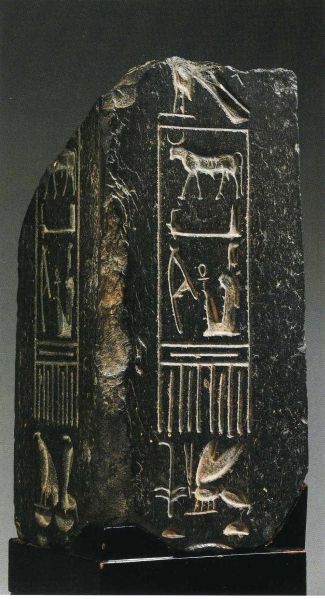
Obelisk, black basalt; Eighteenth Dynasty; 38.7 cm; inscribed with the Horus name "The strong bull, beloved of Maat," private collection.
New Kingdom II-Dynasty XIX
The first ruler of Dynasty XIX was a military man, Ramses I Menpehtyra (1995-1294 B.C.). His name means "created by [the god] Re." The father of
Ramses I, Seti, was a well-known general. Ramses I started as an enlisted solider and worked his way up through the cavalry. Ramses I eventually was made a priest and given power over the Nile Delta. He fought
beside King Horemhab during the last days of Dynasty XVIII.
Ramses I was made king when King Horemhad died without a child. When he ascended to the throne, he was already old and his son, Seti I, was a general.

Coffin of deceased named Henutmehyt, gilded and painted wood; Dynasty XIX, 187 cm; the hieroglyphs say she was "head of the house," and "a musician." British Museum, London, U.K. The coffin was typically made of wood. The mummified body was put in the coffin. The sarcophagus was the outmost level and was typically made of stone. An ancient Egyptian would say that the function of both the sarcophagus and coffin were to protect the "ka" [spirit] of the deceased; to give the "ka" a place to reside. In Dynasties XVIII and XIX, the Egyptians abandoned rectangular coffins in favor of "anthropoid" ones, i.e. ones conforming to the shape of a person.

Both Ramses I and his son Menmare Seti I (1318-1304 B.C.) restored the temples that had been ignored during the Amarna period. They also reasserted Egypt's imperial authority over western Asia and Nubia. Seti I
built a new temple to Osiris (god of the underworld) at Abydos, which had been a sacred site since prehistoric times.
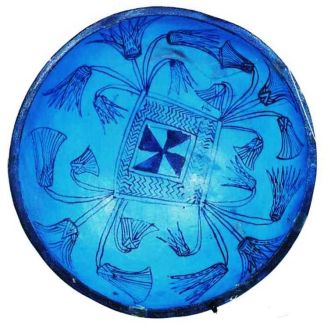
Faience bowl, Dynasty XIX, New Kingdom, Egypt; British Museum, London, U.K. In this piece, the glaze is in particularly good condition. Sometimes the glaze was applied immediately after firing, in the other main method of production, the glaze was applied long after firing while the piece was dry. The ancient Egyptians called faience "tjehenet," which would translate as "dazzling." It was made from the earliest recorded history of Egypt. Faience was painted bright blue. It was ceramic, made of crushed quartz plus lime and ash.
Many Egyptologists praise the craftsmanship of this period as perhaps the best of Egyptian history. Pieces such as the faience bowl above were created under King Seti I for his tomb in the Valley of the Kings. Seti
I had a series of stupendous military successes. He defeated Syria and Palestine; he pacified the Hittites. His most stunning victory was against the Hittite stronghold, the city of Kadesh. The city, however,
was to be fought over by Egypt and the Hittites many times throughout antiquity.
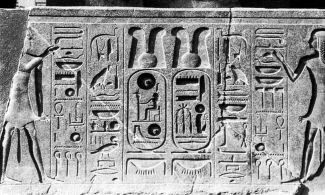
Detail, Temple of Seti I, Abydos; Egypt.
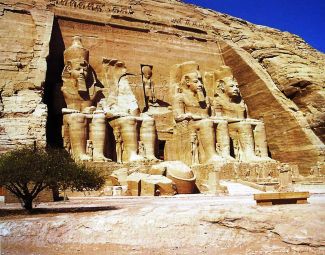
Map showing Kadesh (also known as Qadesh), and related sites conquered by Seti I and his son Ramses II. Kadesh is mentioned extensively in the Bible, in the story of Sarah, with respect to Abraham, Moses and Joshua.
But the Hittites reasserted their control over Kadesh and rebelled against the Egyptians. Rameses II Usermaatra Setepenra (1279-1213 B.C.) undertook a siege of Kadesh soon after taking power as king. Ramses II brought
an army of over 20,000 to re-take Kadesh. The Hittite King Muwatallis cleverly ambushed the Egyptians with nearly 4,000 chariots. Ramses II managed to capture Hittite spies and learn the Hittite king's strategy
from them. Ramses II also got reinforcements at a critical moment from the Regiment of Ptah. Both sides came close to complete defeat. At that moment, King Mutwatallis left with his cavalry. There were peace
negotiations between the Egyptians and Hittites over Kadesh, and the Hittites eventually sent a request for peace carved in a block of silver. According to the peace treaty, subsidiary states were divided between
the Egyptians and Hittites. Ramses II married two Hittite princesses; one in the twenty-third and another in the forty-fourth year of his reign. These marriages helped to consolidate Egypt's peace with the Hittites.

Portion of sandstone wall relief of the Battle of Kadesh (also spelled Qadesh); with King Ramses II shooting arrows at the Hittites from a chariot. Luxor, Egypt.
As a youngster, Ramses II traveled with his father King Seti I, in battles in Libya, throughout the Mediterranean and Syria. In the seventh year of Seti's rule, Ramses II was named co-regent. Shortly afterward,
Ramses II campaigned against Nubia-he was only twenty-two at the time, and took two of his sons with him. He was given the honorific name Userma'atre', which meant "Strong in right is Re."
Ramses II lived to ninety-six years old and outlived some of his sons. His tomb at Thebes was on the west bank of the Nile, directly across from Luxor, and included a ritual boat, the remains of the royal palace,
granaries, and storerooms. Ramses II also built two significant temples one at Memphis to Ptah and another to Amun at Abu Simbel, at the Second Cataract of the Nile.

The Great Temple at Abu Simbel, Nubia. Sandstone; Ramses II, Dynasty XIX, New Kingdom, Egypt. Each seated figure is 22 meters high. Shortly after construction, an earthquake destroyed part of the temple and it has never been restored. The smaller temple at Abu Simbel was dedicated to Ramses II's wife Nefertari.
Abu Simbel, as well as several tombs from the early part of Dynasty XIX in Luxor were excavated by Giovanni Battista Belzoni (1778-1823). Belzoni was a traveling musician. Belzoni originally went to Egypt to sell
waterwheels. Through his sales, he met sponsors for his archaeological adventures. Belzoni's work was important because he thoroughly documented the ancient sites he excavated in watercolors, lithographs, and
sketches.
After Ramses II there was a period of short-lived reigns. Ramses II was succeeded by his thirteenth son Merenptah who was probably in his forties or fifties when Ramses II died. Merenptah ruled from 1213-1202. Dynasty
XIX ended with four pharaohs each of whom only ruled for a few years.
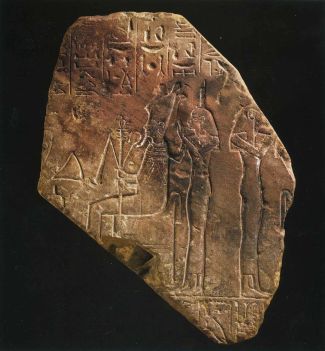
Fragment of sandstone stele; Dynasty XIX; 23 ½ x 17 ¾ inches; private collection, Japan. The goddess Isis wears a wig and high crown. The god Osiris is depicted holding the scepter, wearing the traditional wide collar and crown.
Ramses II is called "The Great" and to many scholars his rule was the height of Egyptian civilization. Ramses II was the first pharaoh to sign a peace treaty (with the Hittites). Egyptian architecture reached its
zenith during his long reign. Though his royal cemetery was at Thebes in the Valley of the Kings, his mummy was found at Deir el-Bahri near his family's home. Ramses II was tall (about six feet tall), but his
mummy shows that he suffered life long health problems.
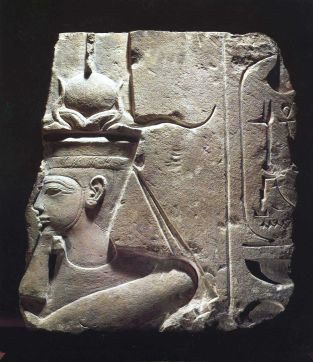
Fragment relief of Ramses II, limestone, ca. 1290-1280 B.C.; 20 inches high; private collection, New York, NY.
|